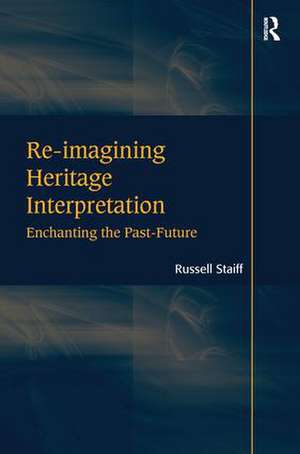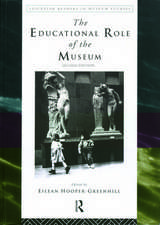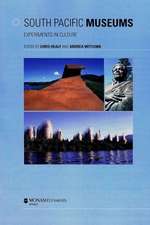Re-imagining Heritage Interpretation: Enchanting the Past-Future
Autor Russell Staiffen Limba Engleză Paperback – 15 dec 2017
| Toate formatele și edițiile | Preț | Express |
|---|---|---|
| Paperback (1) | 356.44 lei 6-8 săpt. | |
| Taylor & Francis – 15 dec 2017 | 356.44 lei 6-8 săpt. | |
| Hardback (1) | 1055.21 lei 6-8 săpt. | |
| Taylor & Francis – 7 ian 2014 | 1055.21 lei 6-8 săpt. |
Preț: 356.44 lei
Nou
Puncte Express: 535
Preț estimativ în valută:
68.20€ • 71.21$ • 56.45£
68.20€ • 71.21$ • 56.45£
Carte tipărită la comandă
Livrare economică 05-19 aprilie
Preluare comenzi: 021 569.72.76
Specificații
ISBN-13: 9780815399957
ISBN-10: 0815399952
Pagini: 202
Dimensiuni: 156 x 234 x 23 mm
Greutate: 0.45 kg
Ediția:1
Editura: Taylor & Francis
Colecția Routledge
Locul publicării:Oxford, United Kingdom
ISBN-10: 0815399952
Pagini: 202
Dimensiuni: 156 x 234 x 23 mm
Greutate: 0.45 kg
Ediția:1
Editura: Taylor & Francis
Colecția Routledge
Locul publicării:Oxford, United Kingdom
Notă biografică
Russell Staiff holds a PhD in art history from the University of Melbourne where he was the foundation lecturer in the postgraduate visual arts and tourism program. He began his life in heritage and tourism as a tour guide in Italy. Currently, he teaches in the heritage and tourism program at the University of Western Sydney and Silpakorn University, Bangkok. He researches the various intersections between cultural heritage, communities and tourism with a particular emphasis on Southeast Asia.
Recenzii
’Eschewing contemporary orthodoxy about the educational presentation of heritage, Staiff compellingly argues for personal, sensory, emotional, dialogic engagement with cultural sites so as to generate a far more meaningful, intense and memorable experience of place -- with or without the products of professional heritage interpreters. The book will fascinate the entire heritage management field.’ Helaine Silverman, University of Illinois at Urbana-Champaign, USA ’To echo the author's words, this is not a heritage interpretation manual. No! It is so much more. This is a rich and vividly articulated evocation of the complex relationship we have with the past, its objects and its intangibles, the things and non-things that we call heritage. Staiff has achieved more than a simple account of interpretation could ever do. With his very individual perspective he has envisioned the very nature of our encounters, engagements and subjective experiences, as individuals, bodies and collectivities. Can heritage interpretation ever be understood in the same way again? Not after this!’ Steve Watson, York St John University, UK 'It will have value to many who enter into these accounts and it will provoke many responses ranging from the positive to the negative but it will provoke! ... It contains many rich and vivid stories, portraying some of the complex relationships we have with our heritages.' European Journal of Tourism Research 'a must for anyone seriously interested in heritage interpretation' International Journal of Intangible Heritage 'This book, by turns stimulating, provocative, challenging, occasionally frustrating but always immensely readable should be an essential purchase for anybody interested in heritage interpretation.' International Journal of Heritage Studies 'For practitioners of heritage interpretation, the book certainly provides a text over which one can ponder. It does, as promised, differ from traditional, manual-style, directive tex
Cuprins
Chapter 1 Prologue: the known, the unknown and other ruminations; Chapter 1a Anecdotes and observations; Chapter 2 Tilden: beyond resurrection; Chapter 3 The somatic and the aesthetic: embodied heritage experiences; Chapter 4 Visual cultures: imagining and knowing through looking; Chapter 5 Narratives and narrativity: the story is the thing; Chapter 6 Digital media and social networking; Chapter 7 Conversing across cultures; Chapter 8 Enchantment, wonder and other raptures: imaginings outside didacticism;
Descriere
This book challenges traditional approaches to heritage interpretation and offers an alternative theoretical architecture to the current research and practice. Russell Staiff suggests that the dialogue between visitors and heritage places has been too focused on learning outcomes, and so heritage interpretation has become dominated by psychology and educational theory, and over-reliant on outdated thinking. Using his background as an art historian and experience teaching heritage and tourism courses, Russell Staiff weaves personal observation with theory in an engaging and lively way. He recognizes that the 'digital revolution' has changed forever the way that people interact with their environment and that a new approach is needed. This book will be of interest not only to students in heritage management, heritage tourism, heritage interpretation and museum studies, but also to museum professionals responsible for interpretation programmes.













